BALANCING PITTA
Contemplate a pot of steaming hot, sour, and spicy stew—that’s the nature of pitta. Hot, shrewd and penetrating, Pitta is a nature’s mix of fire and water in which fire pre-dominates. The pitta dosha is based on fire and water and is associated with a tenacious personality. Hot, light, sharp, oily, liquid, and mobile are some of the typical identifiers of Pitta dosha. Summer is known as pitta season because of its long, hot days.
Pitta acts as the fierce leader among other doshas and Pitta people are said to have a muscular build, to be very fit, and to be strong leaders. They are driven, goal-oriented, and competitive. Pitta’s are intense individuals with a great sense of order and justice. Nonetheless, their violent and tenacious nature can be off-putting to some people, leading to conflict. Seems close to your personality traits!! It is very crucial to know your body constitution for the first step to create a healthier and more balanced lifestyle.
SO WHAT ACTUALLY IS PITTA DOSHA?
Pitta, as the governor of “fire,” is regarded as the transformational force in the body, whether it is converting food into nutrients and energy or thoughts into feelings and emotions. Pitta’s main functions include digestion, metabolism, maintaining the body temperature, color, complexion of the skin, intellect and processing through all of our daily perceptions. Pitta Dosha, which is associated with flames, is the hottest Dosha. This causes inflammation, rage, heat accumulation in the body, and a variety of other symptoms.
Among the three doshas, Pitta is derived from the root word ‘tapa’ which means ‘to heat’. Pitta’s impact on the body is to increase heat. Pitta has a slightly sticky, penetrating, hot, light, odorous, free-flowing, and liquid texture. Pitta drives metabolism or transformation. Unbalanced pitta is characterised mainly by body heat or a burning feeling, as well as redness. Pitta is equally critical in balancing the two diametrically opposed qualities of fire and water. Like fire, which is a fluid in its existential state but burns.
Pitta is the concept that regulates the body’s metabolic transformation, serves as heat energy, and digests food at both the gross and cellular levels. It gives the body warmth, vision, and colour.
| Physical Attributes of Pitta Dominance | Mental Attributes of Balanced Pitta Dominance |
|
|
WHERE PITTA DOMINATES?
The primary home of pitta is the stomach. Other significant areas incorporate:
-
- Stomach
- Umbilicus
- Sweat
- Digestive fire/enzymes
- Lymph
- Blood
- Fat
- Taste buds
- Eyes
- Skin
These areas are prime locations to give indications of pitta imbalance nature like redness, itching or swelling, excess generation of heat in the body, acid reflux, gas, indigestion, inflammation of the joints, nausea, diarrhoea or constipation, anger & irritability, bad breath, body odour and excessive sweating.
Pitta can be thrown off balance by something, from stress to an unhealthy eating schedule, from hyperactive emotions to an inactive way of life. Dosha levels fluctuate regularly throughout our lives. While the question of how to balance pitta dosha is urgent, understanding what causes pitta imbalance in the body is also important. A variety of factors contribute to the accumulation of pitta dosha or pitta imbalance.
Among the most popular of these are:
- Dietary exposure to pitta-opposing or provoking pitta
- Excessive acidic food consumption
- Sunlight exposure
- Excessive chemical exposure
- Stress, either emotional or physical
SIGNS & SYMPTOMS OF PITTA IMBALANCE
Pitta dosha, or heat energy in the body, is imperceptible to the naked eye. It manifests itself in your metabolism. Pitta-dominant constitution particularly in the wintertime, their hands and feet are never cold. Pitta personalities like both sweet and sour flavours. Because of its hot nature, pitta’s primary function is transformative i.e. it regulates heart rate, hormone levels, body temperature, vision, hunger and thirst, and skin texture. It is also in control of liver activity, bile secretion, and digestion in the stomach and small intestine.
Let us now look into the most common symptoms that occur due to Pitta imbalances
- People with Pitta disorders struggle with upset stomachs, heartburn and diarrhoea due to irregular dietary considerations.
- Hyperactive metabolism leads to frequent hyperacidity, burping, perspiration and sensitive emotions, all strong indications that the internal bodily bio-elements have become imbalanced.
- Individuals with Pitta disorders are often workaholics.
- Mostly joint pain with inflammation and swelling in the body is common.
- Increased hunger, thirst, hot flashes
- Excessive hair fall, hormonal imbalance
- Vertigo and migraines
- Bad breath and body odour
- Heavy, painful menstrual bleeding
- Insomnia and depression with anger issues
- Skin problems such as psoriasis, alopecia,
- Conditions affecting the liver and gallbladder
- Emotionally, pitta imbalance makes an individual prone to anger, feeling impatience and frustration, or feeling resentful or judgmental of others.
WHY THERE IS NEED TO BALANCE PITTA DOSHA?
As minor issues go unaddressed, symptoms worsen and spread, making it difficult to monitor the disorder’s manifestation. Attempts to cure the human body while ignoring its elemental and dosha makeup are doomed to fail. Beginning to work with the metabolic essence (rather than against it) benefits all aspects of life. Ayurveda recommends Dinacharya (day-to-day routine), Ritucharya (seasonal routine), Ahara Vichara (diet routine), and Sadvritta to prevent the body from being imbalanced (social routine).
These regimens take into account the season, the region, the time of day, and the individual’s body type, resulting in customised regimens. Along with the regimens, Ayurveda prescribes customary purifying or purificatory medicines intending to remove poisons, ama (free toxins), and so on that have amassed throughout the body purposefully or unintentionally.
So, what do you do when pitta reaches boiling point? There are several basic methods for keeping the inner fire at bay. Keep in mind that the manifestation and severity of doshic imbalances will vary depending on a variety of factors. Early correction of dosha imbalance will help to halt any ailment until it spreads.
A. DIETARY GUIDELINES
Ayurveda has a special diet for the balance of Pitta. The dietary regime for this essential energy is determined by its properties. Pitta characters generally have a strong digestive system and can tolerate virtually any food except pungent, salty or sour. Pitta dominates in middle-age (when work dominates our daily life), in the summer, the second hour after eating and in the midday and midnight hours (10 AM – 2 PM and 10 PM – 2 AM). This is why digestion is at its best at noon and why eating the main meal at this time is beneficial to one’s health.
Here are some dietary guidelines to balance pitta in detail;
1. Prefer sweet over sour
- Consume pitta-calming foods (bitter, astringent, sweet-tasting food). Milk, ghee, butter are good pitta pacifiers. Prefer sweet fruits over sour ones.
- The recommended tastes are bitter, sweet and astringent. These have a constricting, reducing, and cooling effect in general.
- Dairy can help balance the heat of Pitta. This includes milk, butter, and ghee.
- Sour, fermented foods like yoghurt, sour cream, and cheese should be avoided because they aggravate Pitta.
- Except for sugar-based honey and molasses, all other sweeteners are safe to eat and can be consumed in moderation.
- Choose sweeter fruits like raisins, figs, melons, cherries, coconuts, avocados, mangoes, pomegranates, fully ripe pineapples, and plums.
- Sour taste stimulates the gastric juices and the body’s inner fire and invigorates its cells with a heat-generating effect.
2. Prefer Cool over warm
- It is recommended to eat cooling and grounding foods that neutralise pitta qualities, such as basmati rice, bread, milk, ghee butter, melon, or cucumber.
- A pitta-calming diet emphasises juicy, refreshing foods with a high water content while avoiding hot spices, alcohol, vinegar, fried foods, tomatoes, yoghurt, and cheese.
- Seasonings that are calming and cooling should be used by Pitta styles. Coriander, cilantro, cardamom, and fennel are among them.
- Spices with a higher heat level, such as ginger, cumin, black pepper, fenugreek, clove, salt, and mustard seed, should be used sparingly.
- Chili peppers and cayenne pepper are very spicy seasonings that should be avoided.
3. Prefer Dry over Oily
- Balance the oily and moist nature of Pitta with food varieties that are mild, heavy and dry.
- Grains that are recommended include barley, basmati rice, oats, quinoa, and others that are dry, sweet, and cooling.
- Sweet, mild spices like mint and cinnamon are thought to be particularly beneficial for Pitta people.
- Cook with ghee and cooling spices like fennel, coriander, cardamom, and turmeric. Coconut oil and olive oil are also good.
4. Prefer Wholesome, Nourishing pitta pacifying Diet
- Milk should not be consumed before meals but should be consumed at least an hour after or before eating. After having meals, a glass of warm milk with 2 tablespoons of ghee or clarified butter should be taken to help soothe Pitta dosha.
- The vegetables on the menu can be both sweet and bitter.
- Cherries, apricots, apples, grapes, figs, watermelon, and pears should be ripe and delicious.
- Green leafy vegetables, such as cabbage, asparagus, and artichokes, are suggested.
- If possible, foods should be fresh and healthy.
5. Prefer rough over smooth
- Prefer rough over smooth
- Drinking plenty of water during the day is an excellent way to preserve digestive health and a healthy Dosha balance. It is also recommended to drink CCF Tea after meals.
- Regular food consumption is important for Pitta people because their equilibrium can easily be lost and the heat aspect can take over.
- Chew on fennel seeds after meals to reduce stomach acid.
- Avoid processed foods, preservatives, artificial additives, and salty foods, as well as frozen, dried, or bottled foods.
List of Food Choices for Balancing
- Grains: Barley, oats, amaranth, cereal (dry), oats bran, pasta, quinoa, rice (basmati, white, wild), rice cakes, wheat bread, wheat bran, wholewheat bread & pancake and millets in moderation.
- Vegetables: Avocado, asparagus, beets (cooked), bell peppers, broccoli, Brussels semi-boiled sprouts, cabbage, carrots (cooked), cauliflower, celery, cilantro, cucumber, green beans, leafy greens, lettuce, mushrooms, okra(ladyfinger), onions (cooked), parsley, peas, peppers (sweet), potatoes, pumpkin, squash, spinach (boiled), sweet potatoes, zucchini, turnips, green beans, mushrooms.
- Fruits: favour apples, berries, cherries, coconut, dates, figs, grapes (red, purple, black variety), mangoes (ripe), melons, papaya, pears, pineapple (sweet), plums (sweet), pomegranates, prunes, raisins, strawberries, watermelon, sweet plum.
- Lentils & beans: Black beans, black-eyed peas, chickpeas, lima beans, mung beans, all lentils in moderation, pinto beans, split beans etc.
- Dairy: Try organic boiled milk or lassi (sweetened buttermilk), cottage cheese, fresh mozzarella, paneer (a homemade soft cheese,) and goat cheese in small amounts. Avoid sour yoghurt (except as lassi or buttermilk) and all aged or sharp cheese.
- Oils: Ghee or clarified butter, olive oil and coconut oil. All oils should be used in moderation only.
Spices: Cumin, coriander, fennel, cardamom, mint,basil
B. LIFESTYLE GUIDELINES
Start your path to re-tuning the dosha rhythm for a safe life with Ayurveda. The balance of doshas influences fitness (physical, physiological & psychological). Do you ever feel that every time you add another regular activity or schedule, you anyhow have to miss the plan for yet another day? Don’t worry! Here are some lifestyle guidelines you can start with to get your rhythm in tune;
- Get up at Brahma-muhurta: The Ayurvedic classics advocate getting up during the “Brahma-muhurta hours” of the day, between 4:00 and 6:00 a.m. Waking up early is important for avoiding depression because sleeping in the late morning allows impurities to clog the channels of communication, resulting in the dullness of mind, depressive moods, and sluggish communication between heart and mind.
- Start the day off right: Morning elimination is regarded as a natural and essential part of daily hygiene and health in Ayurveda. If you don’t have a bowel movement first thing in the morning, incorporating practices like drinking warm water in the morning will help to control this function in the body.
- Absorb prana from nature: We are all a part of nature, and disconnecting from it can be disastrous. Draw in life-force vitality from the morning rays of the sun, extract nutrients from the earthly dietary products, bathe in soothing and healing waters, and breathe in the fresh air.
- Avoid fasting: Fasting is impractical for Pitta dosha people because it makes them very irritable as they have a big appetite due to their superior digestion and metabolism.
- Reclaim your Sattvic cool: Take part in an intensive meditation called ‘Smile meditation’ which is similar to yoga nidra, where one has to focus the attention, consciousness, and breath on every part of the body, from the toes to the scalp (and everything in between). Meditation for 15-20 minutes while smiling brings profound calmness to the entire being.
- Create a daily schedule and follow it: Pitta is balanced by strong routines that are the polar opposite of its virtues, such as consistency, groundedness, and comfort. Eating and sleeping routinely help to achieve maximal dosha balancing in the body and good health.
- Nourish yourself: Pamper and nourish the body by giving it a regular Abhyanga (ayurvedic oil massage) with coconut oil to improve circulation, and thus providing the skin with the tactile stimulus with calming nature needed to control pitta dosha.
C. HOME REMEDIES
- Amla can be taken as a fruit or in the form of Amalaki capsules as a remedy to manage high Pitta. Amla or Amalaki is one of the best Pitta home remedies that aids in improving the digestive system.
- Practice nasya by adding 3-4 drops of coconut oil or ghee to each nostril.
- Include Pitta balancing Ayurvedic recipes in the dietary menu. Eating any food does not allow one to eat it in abundance. There is a limit on any kind of meal that can be consumed. Consume until the appetite is met. One medium-sized bowl is enough to relieve hunger. Here are some ideas for your kitchenette menu, like
CARROT, BEET, CELERY, AMLA, MINT JUICE

Nutritional facts: Great source of nutrients, pitta balancing,
Cooking time: 15 minutes
Ingredients:
- 2 carrots peeled
- 2 small beets, peeled
- 2 fresh amla, remove the seed
- ½ cup fresh celery
- 1/2 lemon, juiced (~2 tablespoons juice)
- 4–5 fresh mint leaves
- 1/2 cup cool water
Recipe:
- In a blender, combine all of the ingredients and puree until creamy.
- Pour the contents into a cheesecloth-lined nut bag or colander and suck the juice out of the puree.
- Add a few drops of lime juice for taste and serve immediately.
OATMEAL WITH RAISINS, FIGS, SHREDDED COCONUT & GHEE

Nutritional facts: Rich source of fiber and is light & easy to digest.
Cooking time: 20-30 minutesin
Ingredients:
- 2 cups water
- ⅔ cup quick-cooking rolled oats
- 8-10 raisins
- 2-3 figs
- 1 tbsp Coconut sugar
- ¼ cup shredded coconut
- ½ tsp ground cinnamon (optional)
- Clarified butter or ghee
Recipe:
- Bring water to a boil in a saucepan.
- Stir in the oats, raisins, figs, sugar, cinnamon, cardamom.
- Bring to a boil, then reduce to a medium-low flame.
- Simmer, without covering the lid, for 5-10 minutes, or until the liquid has been absorbed and the fruit has softened.
FRUIT SALAD

Nutritional facts: Full of nutrients and fibre content constipation, etc.
Cooking time: 5-10 minutes
Ingredients:
- ⅓ cup fresh lemon juice
- ½ teaspoon grated lemon zest
- ¼ cup dried cranberries
- ½ chopped apple (sweet)
- ½ cup chopped pear (sweet)
- ½ roasted sweet potato
- ¼ cup halved sweet grapes.
- ½ tsp of pumpkin seeds
- 1 cup pomegranate arils
- 1/2 cup soaked almonds
- ⅓ cup coconut sugar
- ⅓ tsp lemon juice
Recipe:
- In a big, clear glass bowl, layer the fruit.
- In a small cup, combine the lemon juice, mint, lemon zest, and honey; drizzle over the fruit mixture and toss to cover.
- Refrigerate 1 hour before serving.
CCF TEA
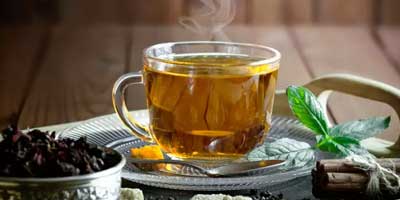
Nutritional facts: Pitta pacifying, no caffeine, digestion-promoting tea.
Cooking time: 20 minutes
Ingredients:
- 1-litre water
- 1 teaspoon Cumin seeds
- 1 teaspoon coriander seeds
- 1 teaspoon fennel seeds
Recipe:
- Mix all the ingredients viz cumin seeds, coriander seeds, and fennel seeds in a litre of water taken in a pan.
- Steep on a medium flame for 8-10 minutes.
- Strain the CCF tea and serve into mugs.
AYURVEDA VATA BALANCING SPICE MIX
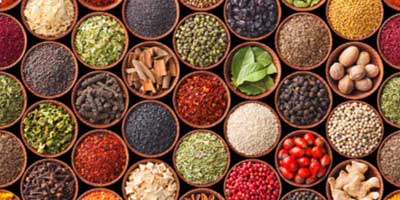
Try this exemplary spice mix formula, which is incredible to taste from your favourite meal, so you get a pleasant dose of warmth.
Ingredients;
- 2 tsp whole coriander seeds
- 2 tsp whole fennel seeds
- 2 tsp whole cardamom seeds
- 2 tsp whole cumin seeds
- 1 tsp ground turmeric
- 2 tsp chopped dried mint leaves
How to use:
In a medium-size wok or vessel, dry roast the herbs and spices. Take care not to blacken or burn the spices. Allow the spices to cool and with the help of a mixer/ grinder, powder them finely. Add dried mint leaves at the end. Pour the ingredients into a mixing bowl and stir with a spoon until thoroughly mixed. Place in an airtight container and keep at a cool room temperature.
Use this Pitta balancing spice-mix either in your vegetable soups, kitchari, stews or dressing over the salads.
Along with pitta pacifying diet and lifestyle guidelines, adopting a consistent routine, on the other hand, is a very crucial and long-lasting act of balancing the doshas. Regardless of what else is going on with lifestyle, our everyday routines provide us with a tangible opportunity to prioritise our health and well-being.
According to Ayurveda, our human body is made up of the same five elements as the nature around us which combine in a particular combination to form the three basic humors known as the tridoshas-Vata, Pitta & Kapha. Ayurveda believes that health is nothing but the amalgamation of a balanced body, pleasant mind and a satisfied soul. Therefore Ayurveda places great importance on maintaining balance as well as re-balancing the imbalances in the doshas of the body.
C. HOME REMEDIES
- Amla can be taken as a fruit or in the form of Amalaki capsules as a remedy to manage high Pitta. Amla or Amalaki is one of the best Pitta home remedies that aids in improving the digestive system.
- Practice nasya by adding 3-4 drops of coconut oil or ghee to each nostril.
- Include Pitta balancing Ayurvedic recipes in the dietary menu. Eating any food does not allow one to eat it in abundance. There is a limit on any kind of meal that can be consumed. Consume until the appetite is met. One medium-sized bowl is enough to relieve hunger. Here are some ideas for your kitchenette menu, like
CARROT, BEET, CELERY, AMLA, MINT JUICE
Nutritional facts: Great source of nutrients, pitta balancing,
Cooking time: 15 minutes
Ingredients:
- 2 carrots peeled
- 2 small beets, peeled
- 2 fresh amla, remove the seed
- ½ cup fresh celery
- 1/2 lemon, juiced (~2 tablespoons juice)
- 4–5 fresh mint leaves
- 1/2 cup cool water
Recipe:
- In a blender, combine all of the ingredients and puree until creamy.
- Pour the contents into a cheesecloth-lined nut bag or colander and suck the juice out of the puree.
- Add a few drops of lime juice for taste and serve immediately.
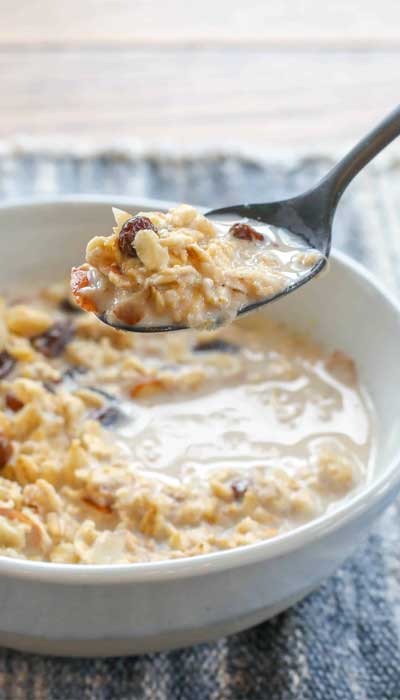
OATMEAL WITH RAISINS, FIGS, SHREDDED COCONUT & GHEE
Nutritional facts: Rich source of fiber and is light & easy to digest.
Cooking time: 20-30 minutesin
Ingredients:
- 2 cups water
- ⅔ cup quick-cooking rolled oats
- 8-10 raisins
- 2-3 figs
- 1 tbsp Coconut sugar
- ¼ cup shredded coconut
- ½ tsp ground cinnamon (optional)
- Clarified butter or ghee
Recipe:
- Bring water to a boil in a saucepan.
- Stir in the oats, raisins, figs, sugar, cinnamon, cardamom.
- Bring to a boil, then reduce to a medium-low flame.
- Simmer, without covering the lid, for 5-10 minutes, or until the liquid has been absorbed and the fruit has softened.
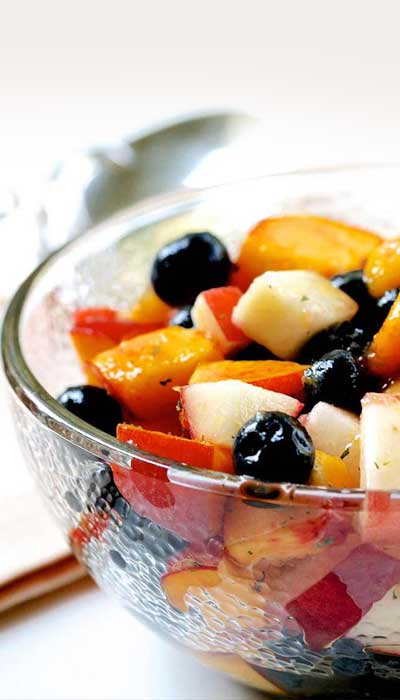
FRUIT SALAD
Nutritional facts: Full of nutrients and fibre content constipation, etc.
Cooking time: 5-10 minutes
Ingredients:
- ⅓ cup fresh lemon juice
- ½ teaspoon grated lemon zest
- ¼ cup dried cranberries
- ½ chopped apple (sweet)
- ½ cup chopped pear (sweet)
- ½ roasted sweet potato
- ¼ cup halved sweet grapes.
- ½ tsp of pumpkin seeds
- 1 cup pomegranate arils
- 1/2 cup soaked almonds
- ⅓ cup coconut sugar
- ⅓ tsp lemon juice
Recipe:
- In a big, clear glass bowl, layer the fruit.
- In a small cup, combine the lemon juice, mint, lemon zest, and honey; drizzle over the fruit mixture and toss to cover.
- Refrigerate 1 hour before serving.

CCF TEA
Nutritional facts: Pitta pacifying, no caffeine, digestion-promoting tea.
Cooking time: 20 minutes
Ingredients:
- 1-litre water
- 1 teaspoon Cumin seeds
- 1 teaspoon coriander seeds
- 1 teaspoon fennel seeds
Recipe:
- Mix all the ingredients viz cumin seeds, coriander seeds, and fennel seeds in a litre of water taken in a pan.
- Steep on a medium flame for 8-10 minutes.
- Strain the CCF tea and serve into mugs.
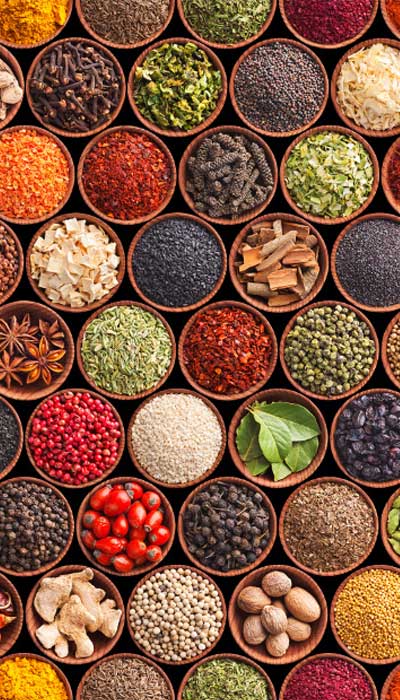
AYURVEDA VATA BALANCING SPICE MIX
Try this exemplary spice mix formula, which is incredible to taste from your favourite meal, so you get a pleasant dose of warmth.
Ingredients;
- 2 tsp whole coriander seeds
- 2 tsp whole fennel seeds
- 2 tsp whole cardamom seeds
- 2 tsp whole cumin seeds
- 1 tsp ground turmeric
- 2 tsp chopped dried mint leaves
How to use:
In a medium-size wok or vessel, dry roast the herbs and spices. Take care not to blacken or burn the spices. Allow the spices to cool and with the help of a mixer/ grinder, powder them finely. Add dried mint leaves at the end. Pour the ingredients into a mixing bowl and stir with a spoon until thoroughly mixed. Place in an airtight container and keep at a cool room temperature.
Use this Pitta balancing spice-mix either in your vegetable soups, kitchari, stews or dressing over the salads.
Along with pitta pacifying diet and lifestyle guidelines, adopting a consistent routine, on the other hand, is a very crucial and long-lasting act of balancing the doshas. Regardless of what else is going on with lifestyle, our everyday routines provide us with a tangible opportunity to prioritise our health and well-being.
According to Ayurveda, our human body is made up of the same five elements as the nature around us which combine in a particular combination to form the three basic humors known as the tridoshas-Vata, Pitta & Kapha. Ayurveda believes that health is nothing but the amalgamation of a balanced body, pleasant mind and a satisfied soul. Therefore Ayurveda places great importance on maintaining balance as well as re-balancing the imbalances in the doshas of the body.
Follow @gayatriayurveda.ca and for consultations, contact;
Call/Direct: 905-872-1851
info@gayatriayurveda.ca

